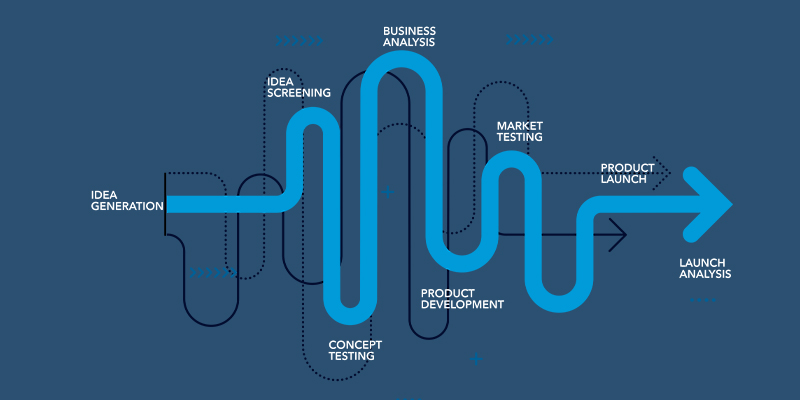
The typical new product development (NPD) process involves a series of stages and gates that a product goes through from conceptualisation to market launch.
In this article we explore how conducting consumer research throughout the NPD process enables business to make confident decisions and maximise the opportunity for success.
Market research plays a vital role throughout the entire new product development process, enabling decision-making at each stage and helping to ensure the resulting product meets customer needs and market demands.
While variations exist, a commonly accepted NPD framework includes the following stages:

Idea Generation
The process begins with generating ideas for new products. Ideas can come from various sources, including customer feedback, market trends, competitor analysis, and internal brainstorming sessions.
Idea Screening
This stage involves evaluating and filtering the generated ideas to identify those with the most potential. Criteria may include market demand, feasibility, alignment with the company’s goals, and profitability.
At this stage, market research can help identify market needs, trends, and potential opportunities. It provides insights into customer preferences and helps in generating viable product ideas. Usage and Attitude studies are fundamental for brands in identifying new opportunities and connections between shopper, consumers, usage behaviour and opinions.
Concept Development and Testing
Selected ideas are then developed into more concrete product concepts.
These concepts are tested with a target audience to gather feedback and refine the ideas based on customer reactions. Online surveys, focus groups, and other research methods help gather feedback, ensuring the product aligns with customer expectations.

Business Analysis
A detailed business analysis is conducted to assess the potential profitability and feasibility of the product. This includes cost estimation, pricing strategy, sales forecasts, and an overall assessment of the project’s financial viability.
Market validation research provides data on market size, potential demand, and competitive landscape. This information is essential for conducting a thorough business analysis and estimating the product’s financial viability.
Product Development
Once the business case is approved, the actual product development begins. This stage involves designing, engineering, and creating prototypes or samples of the product.

Market Testing
In some cases, companies may release a limited version of the product in specific markets to further test its acceptance and gather real-world data. Market research can be used to assess customer reactions, fine-tune marketing strategies, and make adjustments to the product based on real-world feedback.
Product Launch
The final product is launched into the market. This involves mass production, distribution, and marketing activities to create awareness and generate sales.
Launch Analysis
An important stage which is often overlooked is Launch Analysis. This is often done a few weeks after a product is introduced into the market to understand how well the product is being accepted by end-users. Launch Analysis will allow you to understand the shopper and competitor dynamics and allow you to “course correct” should it be performing below expectations.
With extensive experience working in leading global FMCG companies, our team brings a wealth of experience in New Product Development. We have helped companies launch products worth over $500 million in sales, so whether you require a tailored NPD research plan aligned with your specific processes or seek expert guidance in shaping and refining your development procedures, please feel free to get in contact.
If you would like to know more, please contact us.

